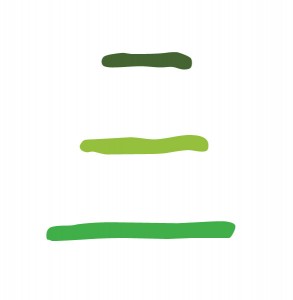There are some people who don’t bother much with punctuation or think that quibbles about commas are purely subjective. In some instances I’d agree with them, but overall, punctuation exists to help you say what you mean. Punctuation helps you emphasize what you want emphasized and communicate nuances of meaning you would add if you were speaking to your reader in person.
That’s why I find the differences between the three members of the Hyphen-Dash family absolutely critical. Just like any other family, the members share some traits, but have their own distinct qualities. Those qualities help you say way you mean when you write. I can’t cover all the nuances of the Hyphen-Dash family here, but I can give you a crash course.
Meet Hyphen
Little Hyphen is the smallest member of the Hyphen-Dash clan. He looks like this: -. For contrast, here’s en dash (–) and em dash (—). He’s so common that you can use him to verb something. And yet Lynne Truss, the delightful author of my favorite punctuation book, Eats, Shoots and Leaves, calls Hyphen “a little used punctuation mark” in her chapter about him. That’s because Hyphen is confusing, and he’s an utter pain to use correctly.
Figuring out when to hyphenate a noun is relatively easy. If you want to know if you should say butter fly, butter-fly, or butterfly, you go to Merriam-Webster, type in any of the options, and see which one pops up. Simple. (Unless we’re talking about something like e-mail versus email, in which case it gets more complicated.)
Hyphenating adjectives trips more people up. I’m going to focus on the trickiest instances. The important thing to remember is that Hyphen exists to clear up ambiguities. Thus, to use Truss’s examples, you hyphenate shell-like because having three Ls in a row is a mess, and you hyphenate de-ice because deice could very easily be a word that meant something other than getting ice to go away.
Hyphenated adjectives work the same way. When you hyphenate two words, you essentially turn them into one word. For example, the phrase ugly bug juice could mean juice from ugly bugs or bug juice that is ugly. If you sprinkle in some of Hyphen’s charm, he can solve that ambiguity: ugly-bug juice is juice from unfortunate-looking bugs and ugly bug-juice is bug juice that happens to be unpleasant to see. So if you have two adjectives in front of a noun, determine whether you’ve laid an ambiguity trap. If you have, use Hyphen to build a bridge over it.
Meet Em Dash
Papa Em Dash is probably the punctuation mark most people get right—fact of the matter is that he’s hard to use wrong. Em Dash stands for an abrupt change in thought, in place of parentheses, in place of omitted letters in a name, for a cut-off statement, and sometimes even in place of quotation marks (though I don’t recommend it).
The problem is that Em Dash is so big (the width of an M in whatever font you’re using) that he draws a lot of attention to himself. So it’s best to limit your use of him. Use him when you need an interruption in your sentence—be that for pacing purposes or for a change in topic—and for very little else. If you use him sparingly, he’ll be more effective.
To get a true en dash in MS Word on a PC, hit CTRL + ALT + the minus key on your keyboard’s number pad (the hyphen key next to the zero is not the same). If you’re writing online, the HTML code for Em Dash is —. Stick the ampersand, mdash, and the semi-colon in your HTML code and you’re good to go.
Meet En Dash
En Dash is probably the least-known and least-understood member of the Hyphen-Dash family. But she can really communicate a lot for a line that is only the width of an N.
According to the Chicago Manual of Style (I call it BOB, for Bright Orange Bible, even if they did put a blue dust jacket on the latest edition), En Dash can stand in for to, signify an unfinished number range, assist with compound adjectives, and a few other assorted uses. It’s easiest to understand this through examples.
Standing for to. 2003–2010 means the years from 2003 TO 2010, whereas 2003-2010 could mean the same thing (incorrectly), or it could mean a file number that includes the numbers 2,003 and 2,010. This use can also appear outside of numbers. You can have a Cardiff–London train, for example, and author–editor interaction (which involves an author and an editor, whereas author-editor interaction is the interaction of one individual, an author-editor).
An unfinished range. 1993– would probably mean the life span of someone who hasn’t died yet. Hyphen is too small to really stand for a continuing life; instead it would seem like he was misplaced on accident. En Dash looks a lot more intentional.
In compound adjectives. Using En Dash with complicated adjectives is the most fun, and it’s also where she’s most important. En Dash connects adjectives made up of multi-word phrases or words that are already hyphenated. Observe: post-World War II years compared to post–World War II years (the first means years after War #2 after the end of the world, the second means after the second World War).
To use an en dash, in MS Word on a PC hit CTRL + the minus sign on your keypad. In HTML, use –.
The Takeaway
If you’re someone who has moaned about the limitations of the written word, but you haven’t taken a closer look at the punctuation options you have, stop moaning and start studying. There could be all sorts of nuances you’re missing out on.






